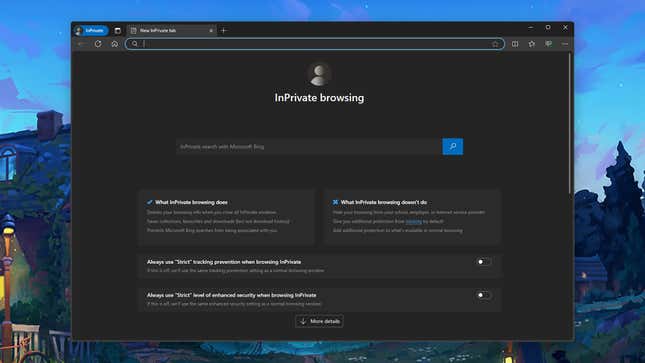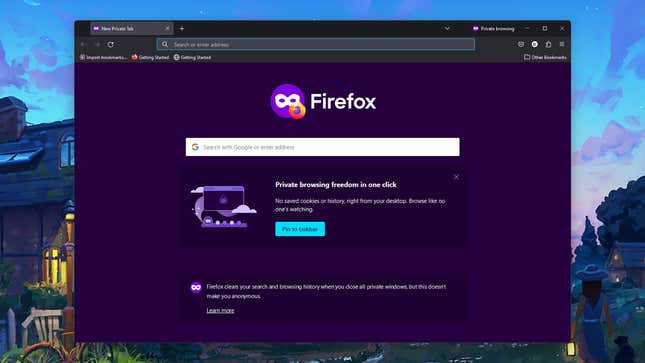Incognito or private mode in most web browsers is back in the news, Google Update its disclaimer Give users a better understanding of exactly how this feature works. The feature works the same whether you use Chrome or one of the alternatives, and it doesn’t cover your tracks as well as you might think.
If you’re going to use incognito mode, you’ll want to know exactly what’s being logged and what’s not being logged while browsing to avoid any nasty surprises.Here we lay out all the details, which should give you a better idea
What is not tracked?
Incognito or private mode is best for accessing places on the web that you don’t want to show up in your browsing history. You can probably think of a few website categories that might apply without us listing them here, but if you need to research a sensitive medical issue, this might be one reason to load the incognito label.
When you close a tab in this private mode, you can’t bring it back as quickly as usual: your browser has forgotten you ever opened it. Sites you visit while browsing privately won’t show up as auto-suggestions when you start typing a new URL into your browser’s address bar.
Incognito mode also blocks cookies, those small pieces of data stored on your computer or phone that tell websites information about you and your preferences. Since cookies are not stored, you may find yourself logged out of all your usual websites and web applications, and you may see a series of special offers and newsletter signups appear (because these sites will think you are visiting this for the first time).

Additionally, data entered into web forms (such as usernames, passwords, and addresses) will not log you into Incognito Mode as it normally would. However, if login details and other information are stored in your browser, you can still access this data when browsing privately.
In some ways, Incognito Mode is a bit like a throwback to the early days, when separate logins for browsers and accounts to sync everything across multiple devices weren’t the norm. This works best if you hide your browsing from people you share the same device with, but these days, your browsing history is pretty well protected from the prying eyes of others anyway.
Essentially, incognito mode is like your browser temporarily not participating in your web activity – it forgets that the browsing session ever took place. The problem with incognito mode is that we are now being tracked in a number of other ways as well, which is where the limitations of this form of private browsing start to show.
What will be tracked?
Incognito mode, or private mode, focuses a lot on the information stored on the device you’re using, and it doesn’t do much to stop all the other tracking of you across the web. Put it this way: If you’re logged into your Amazon account, whether you’re in Incognito mode or not, Amazon will still know about it.
If you then search for products on Amazon, Amazon will remember those searches, but Chrome, Edge, or whatever browser you use will not. If you add items to your basket, Amazon will remember them. Once you’re logged in somewhere, many of the protections provided by incognito mode disappear.
Your internet service provider will still know what you’ve been viewing, and if you’re in an education or workplace setting, your browsing may also be monitored by staff at your institution or company. Files you download won’t disappear, nor will any bookmarks you saved while browsing in incognito mode.

Installing a VPN (virtual private network) app can give you more protection against all forms of tracking – firstly, it hides your activity from your internet provider – but when logged into Amazon (or Facebook, Google) The same rules apply): these sites will start spying on you as soon as you identify yourself.
Incognito mode doesn’t mean you’re anonymous online; no one else can see what you’re doing, or websites and apps can see where you are in the world, and that’s where some of the confusion comes from. It doesn’t really do anything extra to protect the data going to and from your device either, although browsers do a good enough job at this now whether you’re in private mode or not.
Incognito mode still has its uses, especially on shared devices, but you need to be aware of its limitations.For example, if you want to browse the web without leaving any traces, or stop big tech companies from tracking you, you will need to take further action, such as regularly deleting your browsing history and browser cookies.
Need more help?
How to tell which GPU you have inside your PC or laptop
Here are some simple ways to make Windows more secure
How to use Google Password Manager on any device
How to Get Better Frame Rates in PC Games
How to start running emulators on PC and Mac
Want more of Gizmodo’s consumer electronics picks?Check out our guide best mobile phone, best laptop, best tvand best headphones.If you want to know about the next big thing, check out our guide Everything we know about the iPhone 16.